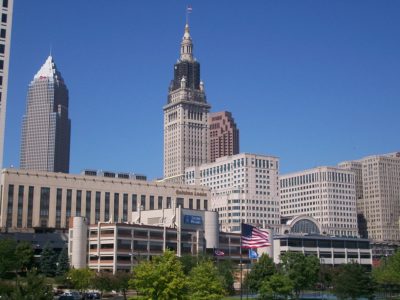“Our job is to notice what the region is ready for, but not yet acting on; the places where a civic shove is needed. It takes patience and persuasion.” – Bethia Burke, president, Fund for Our Economic Future
 You know the image of a tiny clown car? That is how the Fund for Our Economic Future may appear to the outside world. We are an organization with a mission to drive an equitable economy for Northeast Ohio, a region of 4 million people and $200 billion in output, with our comparatively small budget. But, open the door, and the resources keep pouring out: a large and respected civic network, a flexible pooled fund, deep understanding of what matters and what works for equitable growth, staff expertise, a boundary-pushing portfolio of initiatives, and a strong national reputation. These resources have been built over nearly 20 years.
You know the image of a tiny clown car? That is how the Fund for Our Economic Future may appear to the outside world. We are an organization with a mission to drive an equitable economy for Northeast Ohio, a region of 4 million people and $200 billion in output, with our comparatively small budget. But, open the door, and the resources keep pouring out: a large and respected civic network, a flexible pooled fund, deep understanding of what matters and what works for equitable growth, staff expertise, a boundary-pushing portfolio of initiatives, and a strong national reputation. These resources have been built over nearly 20 years.
One of the most important ways we use our resources to influence change is through awareness building on critical issues in Northeast Ohio. We have changed the conversation from growth-first economic development to one of inclusive economic growth deliberately calling for attention to race and place. This work has led to changed actions that have resulted in improved outcomes for people in our region.
At the Fund, awareness building is about more than running marketing campaigns. Here are some shared characteristics of what’s made this work successful:
- Shape what’s next. Every issue has its time. Our job is to notice what the region is ready for, but not yet acting on; the places where a civic shove is needed. It takes patience and persuasion. For instance, in early 2018, we published The Two Tomorrows, a forthright report that called for Northeast Ohio leaders to put racial and economic equity first in economic development decision-making. We certainly weren’t the first to call out racial disparities in the economy, but our position and how we framed and delivered the message enabled others to become more explicit about naming racial inequity in civic conversations—and changes in civic strategies followed.
- Build robust communications strategies. To raise important issues onto the civic agenda, we spend our energy, money, and reputation. Communications is more than a support function; it is a strategy unto itself. Because communication work isn’t direct service, it can be under-resourced. When we reframed “communications” as “awareness building,” our members could understand the long-term importance of the work to getting to better outcomes for people. And awareness building does pave the way for real change, by laying important groundwork, making the business case, and illustrating how new ideas and initiatives can drive change.
- Fill leadership vacuums. We focus our energy on the places where “but for the Fund” an issue or initiative would not advance, and we resist the urge to invest deeply in areas that are not our expertise. For years, we have pushed on the idea that where jobs locate matters and that more is needed to bring jobs to people and people to jobs. No one else was carrying the torch on the importance of job access like we were and so we continued to explore where we could add the most value to advance this issue. Enter The Paradox Prize, an effort funded in partnership with the National Fund for Workforce Solutions, that strove to generate solutions to address the “no car, no job; no job, no car” paradox through a public competition that simultaneously gave us a platform to talk about the importance of job access.
- Be willing to fail publicly. Our goal is success! But, by definition, we work on ideas that are untested and issues that aren’t yet embraced in the civic ether. We are willing to stick our collective necks out to push new ideas and say hard things. Being a collaborative helps; we are backed by an army of 40 members, and we are sticking our necks out together
- Leverage collective action. We are a regional, cross-functional, diverse set of leaders learning, growing, and shaping ideas together. We benefit from each member’s individual influence to move important issues forward across the region. At the same time, our members benefit from the “collective cover” of the Fund, through which they can lead on issues they might be more reluctant to lead on individually or within their own organizations.
A regional collaborative using influence to drive change finds itself walking a tightrope. The work requires focus, commitment, and—above all—balance. Balancing competing interests among partners while keeping the mission front and center; balancing how to celebrate successes and simultaneously share the stage with members and partners who make the work possible; and balancing language, so it resonates and is accessible but doesn’t water down tough messages.





